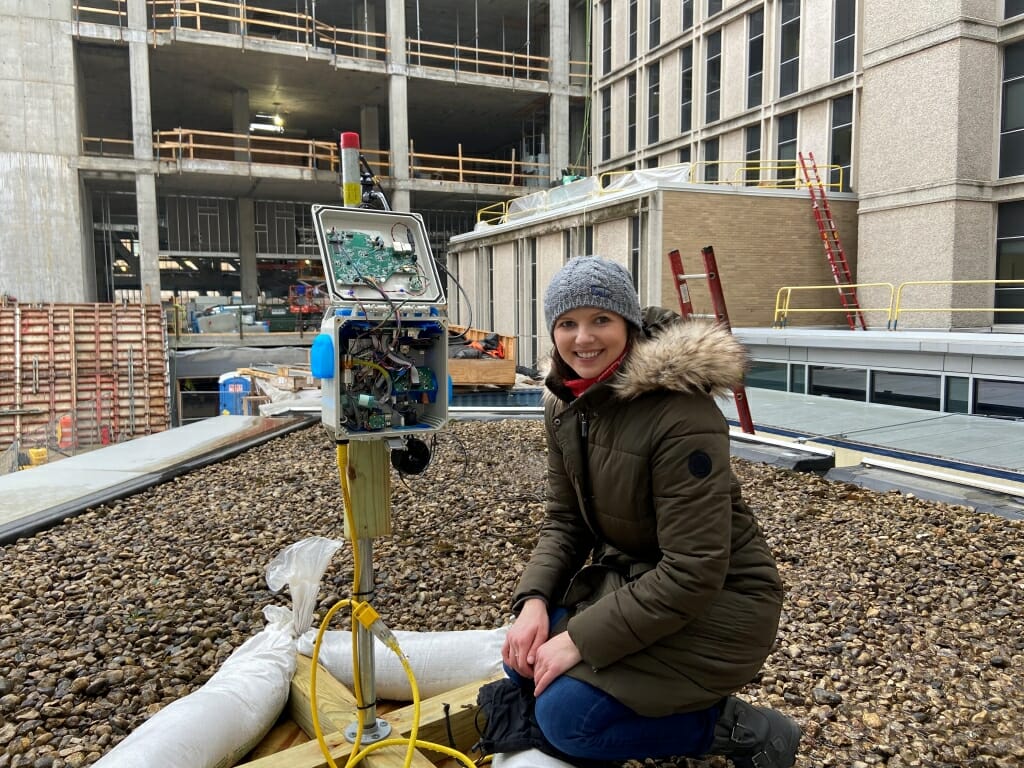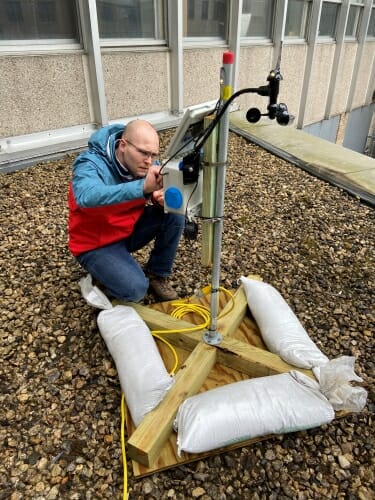Chemists look for ways to assess and improve indoor air quality

Stephanie Richards, a UW–Madison Department of Chemistry graduate student, evaluates the cellular connection status of a QuantAQ sensor package. Photo by Joseph Gord
In a city teeming with traffic, it’s common to smell exhaust and other air pollutants on the street. But air pollution doesn’t always stay outside. Fluctuations in outdoor air quality can cause changes in indoor air pollution, which can lead to respiratory and cardiovascular diseases, cancer, and can adversely affect pregnancies, according to the National Institutes of Health.
Chemists at the University of Wisconsin–Madison are working to better understand how air quality fluctuations outside of a building affect the composition of air inside. The project is a collaboration between the Department of Chemistry and Johnson Controls, which works in heating, ventilation, air conditioning and smart building technology.

Assistant Scientist Joseph R. Gord, from the UW–Madison Department of Chemistry, checks the operation of a miniature pump which provides constant gas-throughput for an optical particle counter. Photo by Stephanie Richards
“The building is alive and responds to episodic changes in air quality,” says chemist and lead researcher Tim Bertram, citing increases in wildfires and exhaust from traffic flow. “An air filtration system that could respond to those changes would offer the benefits of clean air, without a continuous cost.”
To make this idea a reality, the researchers must first determine how the quality of outside air affects the air inside a building and if changes in air quality can be assessed quickly enough to make filtration decisions. To do so, the Bertram group teamed up with Boston-based QuantAQ to deploy four outdoor air quality sensors around the Department of Chemistry’s building complex in Madison and one within the building.
“We want to know if we can measure air quality around the building,” Bertram says. “We also want to determine what controls the variability of local air pollution and if we can measure it fast enough to make a decision.”
Though other systems for air quality assessment already exist, information access takes too long to allow for immediate adjustments in filtration. The QuantAQ sensor packages measure three sizes of particulate matter, as well as levels of ozone, nitric oxide, nitrogen dioxide, carbon monoxide, and carbon dioxide, any of which could lead to lung damage and other health problems. The sensors also track meteorological data, including humidity, temperature, atmospheric pressure, wind speed and direction, solar irradiance, and noise.
The data are automatically uploaded to a server, allowing the scientists to assess possible correlations between things like the sun’s rays and an increase in ozone, or an increase in noise and the presence of an idling vehicle’s exhaust.
“We can see graphs that show how much of each pollutant is present and how it lines up with each sensor,” says Stephanie Richards, a graduate student on the project. “The system uploads five, one-minute averages every five minutes, so we get 60 points per hour, per sensor.”
Johnson Controls, which funded the research, may be able to use the results of this research to create technology that could determine when air filtration is needed, and building designers could use this research to determine the best locations for air intakes.
For now, the current project is focused on air quality correlations, which lets the researchers do what they do best.
“We get to focus on the chemistry problems of what’s happening around the building,” says assistant scientist Joseph Gord, “and how we might address any air quality issues.”
